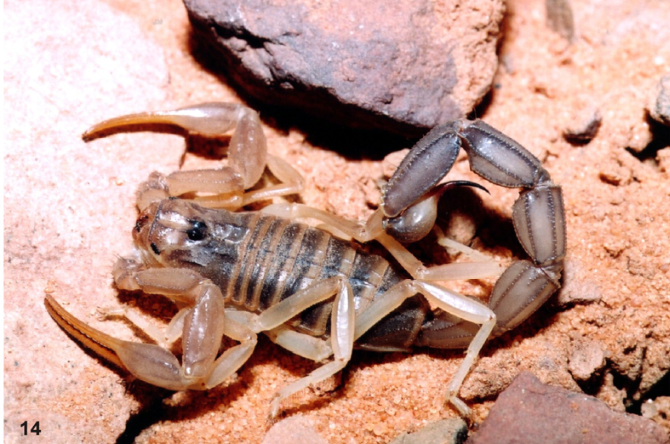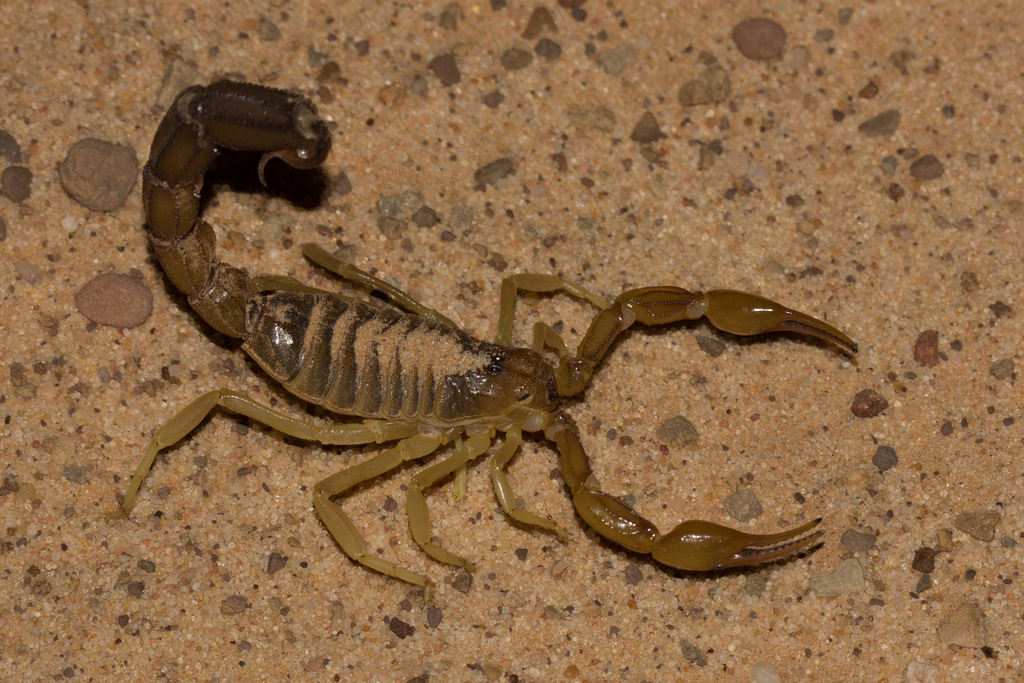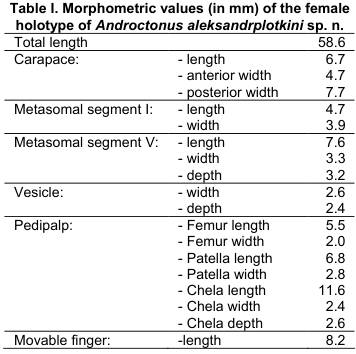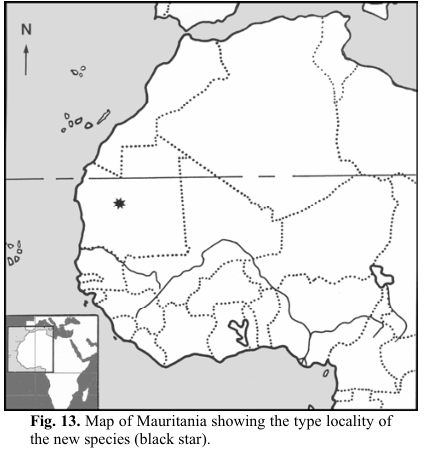Androctonus aleksandrplotkini (Lourenço & Qi, 2007)
Androctonus aleksandrplotkini [Lourenço & Qi, 2007*]
Buthacus maliensis Lourenço & Qi,2007 is synonymized with Androctonus aleksandrplotkini Lourenço & Qi, 2007.
REF-
A NEW SPECIES OF ANDROCTONUS EHRENBERG, 1828
FROM MAURITANIA (SCORPIONES, BUTHIDAE)
Wilson R. Lourenço1 & Jian-Xin Qi2
Androctonus aleksandrplotkini sp. n.
Fig. 1-14. Table I.
HOLOTYPE: Mauritania, Terjit, South of Atar, 8/I/2005 (Ph.
Geniez). 1 female holotype. Deposited in the collections of
the Muséum national d’Histoire naturelle, Paris.
ETYMOLOGY: Patronym in honor of Mr. Aleksandr Plotkin,
Riga, Latvia for his kind investment to the research of bio-
logical diversity.
DIAGNOSIS: A scorpion of medium size, reaching a total
length of 58 mm in the female. General coloration yellow to
yellowish-grey, with thin reticular spots over the body and
appendages. Carinae on carapace moderately to strongly
developed. Metasomal segments I to V narrow and of
216
approximately the same width; dorsal depression on seg-
ments I to IV shallow. Anal arc with three sharp lobes and a
small fourth lobe. Fixed and movable fingers with 11/12
rows of granules. Pectines with 24-23 teeth in the male.
RELATIONSHIPS
Androctonus aleksandrplotkini sp. n., can be distinguished
from the other species of Androctonus which are also dis-
tributed in Mauritania and South of Morocco, by the follow-
ing characters: (i) its overall yellowish coloration with thin
but conspicuous dark reticular spots over the body and ap-
pendages (ii) metasomal segments I to V narrowed with a
shallow dorsal depression; absence of any conspicuous
spinoid granules on dorsal carinae; segment II with 8 cari-
nae (iii) fingers of the chela with 11-12 rows of granules,
(iv) anal arc with 3 sharp lobes and one small latero-dorsal
lobe.
DESCRIPTION BASED ON FEMALE HOLOTYPE.
Measurements in Table I.
Coloration. Mainly yellow to yellowish-grey, giving a
bluish to purplish appearance in living specimens (Fig. 14).
Prosoma: carapace yellowish with thin but conspicuous
reticular spots, better marked laterally; carinae and eyes
marked by dark pigment. Mesosoma: yellowish with con-
fluent reticular spots; carinae slightly marked with dark
pigment. Metasoma: segments I to V yellowish with cons-
picuous dark reticular markings, more conspicuous on IV-
V; carinae coloured with dark pigment; vesicle yellowish
heavily spotted on lateral and ventral faces; aculeus yellow-
ish at its base and dark at its extremity. Venter yellowish;
genital operculum and pectines pale yellow. Chelicerae
yellowish with thin variegated spots on the anterior half;
fingers yellowish with dark teeth. Pedipalps: yellowish with
a thin dark reticular drawing; fingers with the oblique rows
of granules dark. Legs pale yellow with vestigial dark spots.
Morphology. Carapace moderately granular; anterior mar-
gin almost straight and without a median concavity. Carinae
moderately to strongly marked; anterior median, central
median and posterior median carinae moderately to strongly
granular. All furrows moderate to weak. Median ocular
tubercle somewhat anterior to the centre of carapace. Eyes
separated by two and a half ocular diameters. Four pairs of
lateral eyes: the first three of moderate size, the last only
slightly reduced. Sternum triangular and narrow; longer
than wide. Mesosoma: tergites moderately to weakly granu-
lar. Three longitudinal carinae moderately crenulate in all
tergites; lateral carinae reduced in tergites I and II. Tergite
VII pentacarinate. Venter: genital operculum divided longi-
tudinally, forming two oval plates. Pectines: pectinal tooth
count 24-23 in female holotype; middle basal lamella of the
pectines not dilated. Sternites without granules, smooth with
elongated spiracles; four moderately marked carinae on
sternite VII; other sternites acarinate and with two vestigial
furrows. Metasoma: segment I with 10 carinae, strongly
crenulated; segments II to IV with 8 carinae, crenulated;
lateral inframedian carinae represented on segment II by 3-4
granules; the first four segments with a smooth shallow
dorsal depression; segment V with five carinae; the latero-
ventral carinae crenulate with several lobate denticles; ven-
tral median carina not divided posteriorly; anal arc com-
posed of 11/12 inconspicuous ventral teeth, three sharp
lateral lobes and one small latero-dorsal lobe. Intercarinal
spaces slightly granular to smooth. Telson with some strong
granulations on ventral surface; aculeus moderately curved
and slightly shorter than the vesicle, without a subaculear
tooth. Cheliceral dentition as defined by Vachon (1963) for
the family Buthidae; external distal and internal distal teeth
approximately the same length; basal teeth on movable
finger small but not fused; ventral aspect of both fingers and
manus covered with long dense setae. Pedipalps: femur
pentacarinate; patella with eight carinae but only dorso-
internal and internal are well marked; other carinae vestig-
ial; chela with only vestigial carinae; all faces weakly
granular to smooth. Fixed and movable fingers with 11/12
oblique rows of granules. Internal and external accessory
granules present, strong; three accessory granules on the
distal end of the movable finger next to the terminal denti-
cle. Legs: tarsus with numerous thin setae ventrally; tibial
spur moderate on legs III and IV; pedal spurs moderate to
strong on legs I to IV. Trichobothriotaxy: trichobothrial
pattern of Type A, orthobothriotaxic as defined by Vachon
(1974). Dorsal trichobothria of femur arranged in β (Beta)
configuration (Vachon, 1975).



 Photo by
Photo by 

No Comments